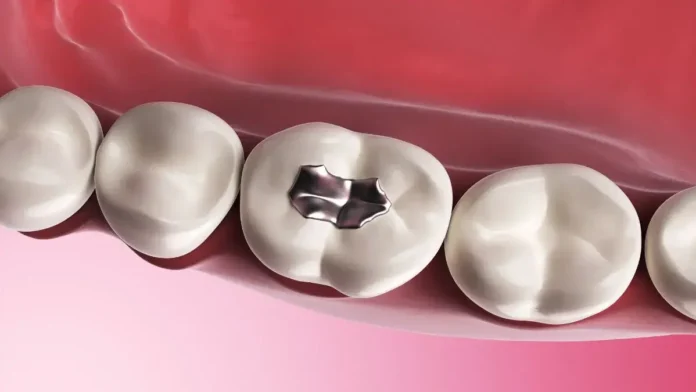Dental Fillings mean to fill the gap, Dentists use various materials combined including metal, glass, plastic, resin, and much more to fill the part of a tooth that they removed due to caries or decay. Dental fillings are also used in cases of broken teeth or cracked teeth, in case of cervical abfraction.
Types of Dental Fillings/Tooth Fillings
Mostly, there are two types of dental fillings is there;
- Direct Filling/Restoration
- Indirect filling/Restoration
Direct Filling or Restoration
Direct Restoration can be done with (1) Silver filling, (2) Cast gold filling, (3) Glass ionomer filling, and (4) Composite Resin filling.
1. Silver filling
Also known as amalgam filling.
Pros :
- It has high strength against chewing force.
- It has the greatest durability among all dental filling materials.
- It may be less expensive than others.
Cons :
- The silver filling is unesthetic as it doesn’t match the tooth color.
- While preparing the cavity, it removes healthy tooth structure also, to make enough space for a mechanical bond of amalgam.
- Amalgam filling sometimes creates a greyish hue surrounding tooth structure.
- In some people, there is an allergic reaction to amalgam restoration due to mercury present in the amalgam.
2. Cast gold filling
Pros :
- The cast gold filling has the greatest strength and durability as compared to other dental filling materials.
- In some areas, gold filling is highly demanding due to eye-pleasing as compared to Silver amalgam.
Cons :
- Cast gold filling is 10 times more costlier than other dental filling materials.
- Requires multiple visits to the dentist.
- In galvanism, when a cast gold filling is placed on the opposite tooth or near the tooth, it will cause a sharp pain due to the interaction between saliva and metals which cause electric current-like pain.
- The majority of patients dislike colored restoration, they prefer tooth-colored material as compared to others.
3. Glass ionomer cement
Pros :
- Glass ionomer cement is usually made up of specific acrylic and glass.
- Glass ionomer cement is frequently used in larger cavities, below the gingival margin, and fillings in young children.
- Glass ionomer cement has the property to release fluoride, which protects the tooth from further decay and also helps to remineralization of affected dentin.
- The newest generation of Glass ionomer cement has the longest durability and strength when placed in appropriate areas as compared to composite.
Cons :
- Glass ionomer cement has a shorter durability as compared to amalgam and composite restorative material.
- It has a weaker strength compared to other restorative materials, so it is prone to quick wear and tear.
- Glass ionomer doesn’t have shade options so it’s not perfectly tooth-coloured restorative material as compared to other tooth-coloured restorative material.
4. Composite
Composite is a tooth-colored, highly aesthetic filling material.
Pros :
- Composite filling material requires minimal tooth preparation, as the decayed parts of a tooth should be removed as compared to amalgam, it requires larger cavity preparation for a mechanical bond.
- Composite filling micromechanically bonds to the tooth surface, providing the greatest retention.
- The composite filling material is more versatile, it can be used to repair, chipped, broken, or fractured teeth.
- Composite material is available in various shades to be closely matched with the shade of existing teeth.
- Highly recommended in the anterior tooth or visible portions of the tooth.
Cons :
- Composite filling material does not last as long as Silver Amalgam if it is used in larger cavities.
- It wears out or discolored after such a period of time.
Which dental filling material is suited for my tooth decay ??
Don’t worry! It will be suggested by your dentist will recommend you, based on your tooth decay, the extent of cavities, and the location of the tooth.
Indirect Filling or Restoration
Indirect restoration is the same as tooth-coloured restoration like composite except it is constructed in dental laboratories so it requires more than two appointments.
In the first appointment, cavity preparation is done and an impression is taken and sent to the laboratory. A temporary restoration can be placed until restoration is made.
In the second appointment, the temporary filling is removed, and the permanent restoration, if it fits accurately, fits permanently with dental cement.
There are two types of indirect restorations, (A) Inlay and (B) Onlay.
(A) Inlay : It’s similar to filling but entire work limits within cusps or chewing surface.
(B) Onlay : Onlays are also known as partial crowns because they require more coverage than surfaces.
Both are more durable and longer lasting as compared to other traditional filling materials.
Another type of direct inlay and direct Onlay are also available. It can be completed in the first appointment only. The difference is it is made in the dental office only so we can place it at the same time.
Dental Filling materials and their properties
| AMALGAM | COMPOSITE | GLASS INOMER | GOLD | |
| Non Tooth colored | A mixture of Mercury and silver alloy | Tooth-colored | Tooth-colored | |
| Description | Strong, durability is good | Used as filling in a cavitated tooth, as partial crown, veneers, fractured anterior tooth | Self-adhesive bond to tooth doesn’t require removal of healthy tooth | A mixture of glass and organic acids |
| Setting Reaction | Set by Chemical Reaction | Set by Light reaction i.e.blue LED light | Self Reaction | Thermoplastic reaction |
| Uses | Used in large cavities, sometimes replaced to fracture cusps | A mixture of powered glass, Resins, and silica Particles | Used in Smaller Cavities, liners, base, or temporary restorations | Used in Occlusal pit, buccal pit, and nonaesthetic areas, also used in atypical lesions like retrograde root canal filling |
| Durability | Long-lasting durability as compared to other restorative filling material | Longer-lasting restorative material | Lesser strength can be used in non-stress-bearing areas | Nobel metal filling, which does not undergo Tarnish & Corrosion. |
| Tooth Structure preservence | It requires the removal of healthy teeth due to mechanical retentive properties. | Self-adhesive bond to tooth, doesn’t require removal of healthy tooth | Self Adhesive, bond adhesively healthy Enamel and Dentin | Self retention property |
| Safety | Allergic reaction was found but in rare condition | No allergic reaction was found | No allergic reaction but chances roughening of a surface may predispose plaque accumulation and compromised periodontal health | No adverse effects are seen |
| Esthetic | Good, Tooth-colored restorative material | Low, filling depends on their size | Very poor, silver colored Restorative material | Very poor, dark Yellow in appearance |
| Cost | Moderate, depending on Cavity | Moderate but higher than other restorative material | Excellent, seems like a natural, various shades are also available | Very Expensive material |
| In Office Visits | Single visit | Single visit ( Multiple Visits for indirect restorations) | Single Visit | Multiple Visits |
| Toxicity | Mercury toxicity may be seen | Good bonding but there are chances when bonding to dentin, no corrosion | Safe, rare allergy to some alloys | Allergic reaction to metal ( specifically Gold-Nickle alloy |
| Microleakage | Not seen, Selg sealing by corrosion | Safe, no allergic alloys are used | Excellent Marginal integrity | A mixture of powdered glass, Resins, and silica Particles |
| Resistance to Fracture | The tooth around the filling may be fractured under stress | Good resistance to fracture | Moderate, Chances of fracture over time | Heavy Occlusal Force loading |
Frequently asked questions
Q1. Why require indirect restoration?
Answer : It is considered when direct filling is not possible due to more tooth structure loss and not enough tooth structure to support or strength, we can go for indirect restoration.
Q2. What is temporary restoration?
Answer : When permanent restoration can’t be placed in the first appointment, temporary restoration is used. It has lesser strength compared to permanent so it is easily removed, broken, or worn out.
Q3. What are the uses of temporary restoration?
Answer : Once a cavity preparation is done and go for indirect restoration, after root canal treatment, allow your nerves to settle down we can use temporary restorative material.
Q4. How should we care for Dental filling once it gets done?
Answer : Maintain good oral hygiene by Brushing with an ultra-soft bristles toothbrush and fluoridated toothpaste and flossing once a day, if possible use a water flosser Keep your dental visit regularly twice a year.
Q5. How do I know a Dental filling needs to be replaced?
Answer : When you feel an extremely sensitive tooth you feel a sharp edge once you notice a crack in a filling or a piece of filling is missing Filling fails and decay develops Visit your dentist, and get regular dental checkups done.
Q6. Is toothache possible after getting a dental filling?
Answer : Yes, there are many different reasons for pain after dental fillings,
- If there are some high points in restoration, reshape the filling.
- If two opposite materials are getting in touch as silver amalgam restoration is already done and the new one is gold or composite, two dissimilar metals create pain. It will be normal within a shorter period.
- If decay is very deep and very near to the pulp means the surrounding tissues are not healthy, and root canal treatment is needed.
Q7. Are Silver amalgam fillings safe?
Answer : In some patients, it is not safe like patients with impaired kidney functions, patients who are planning to become pregnant, people with allergies to mercury, and children below 6 years of age.
The FDA doesn’t recommend removing dental amalgam if amalgam is in good condition due to the increased risk of mercy vapor, it results in more risks than benefits.
I hope this informative article helped you to understand various dental fillings, their properties, uses, advantages, disadvantages, etc. If you have any questions you can ask us in the comment section below.

